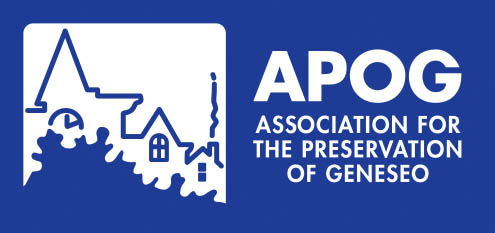Village Park
On July 25, 1976, a plaque, the gift of Mr. and Mrs. William P. Wadsworth, was installed in the Geneseo Village Park. This plaque, mounted on a large boulder, formally dedicated the park to the memory of Elizabeth Wadsworth Murray.
Elizabeth Wadsworth was born in Geneseo on July 26, 1815, the youngest of five children born to James and Naomi Wolcott Wadsworth. Her early years were happy ones, spent in the warmth and security of a wealthy, distinguished, and intellectually stimulating family who were deeply devoted to one another and to the beautiful valley that surrounded them.
Permanently ingrained in his children was James’ love and concern for the natural splendor of his vast lands, and his sense of responsibility toward the tenants who worked them. His contributions toward educational advancement in Geneseo were multitudinous and well known.
In 1831, when Elizabeth was sixteen, her mother and Cornelia, the sister nearest her own age, died. Two years later her other sister, Harriet and her uncle, the bold and dashing William, followed them. Elizabeth, at age eighteen, was left with a grief-stricken father and two older brothers, James and William.
In 1834, James married the lovely Mary Craig Wharton of Philadelphia and, after a year’s tour of Europe settled at Hartford House (which he built immediately upon his return, at the opposite end of the village from the Homestead). William had married Emmeline Austin of Boston and spent most of his time in that city during the first years of their marriage.
The brothers’ young sister, Elizabeth, had grown into a beautiful and gentle woman, refined and intelligent, with the self-discipline so often seen of a true aristocrat. In about 1835 she fell helplessly in love with a Scottish traveler, Sir Charles Murray, who was visiting in the valley. Sir Charles, the son of Lord Dunmore, a Scottish nobleman, proposed marriage and they were engaged.
Her father, thoroughly anti-British and by now, understandably bitter and lonely, in a cruel and uncharacteristic Wadsworth act, forbade the marriage. True to her deep sense of propriety, so much a part of her upbringing, Elizabeth obeyed him, and Sir Charles returned to his homeland, alone.
For the next eight years, Elizabeth cared for her father and managed his household for him. After his death in 1844, she continued to live at the Homestead. Her position during these next years was unique, as a lovely, intelligent, sensitive, and very wealthy young woman, living alone and managing her household and huge estate. Although her brother James and his growing family lived nearby, they often spent months away from Geneseo.
Elizabeth had a wide circle of friends in Boston, New York and Philadelphia, whom she saw at intervals, but no close friends in her beloved valley. Her gardens and her books were her chief companions. It was a way her father would have approved – miles of natural meadows and forests, preserving what had been there when he had come as a pioneer.
Her fellow villagers regarded her with respect, admiration and affection, tinged with awe. Civic minded, Elizabeth never failed to enter the County Agricultural Fair held annually in September. The local press, reporting on the Fair of 1846, noted that Miss Wadsworth had exhibited, “an exquisite collection of flowers, which after being displayed, were parceled into bouquets among the ladies for an evening party.”
c. 1900
Courtesy of Jon and Liz Porter
In the spring of 1845, the Commissioner of Highways received an application from Miss Elizabeth Wadsworth requesting that South Street be altered, from the east side of Second Street to the east line of the Mt. Morris Road, as she was “very desirous of enlarging and improving the north grounds of the mansion.” The Homestead, at that time was considerably smaller and situated considerably nearer the road than it is today. The commissioner and the village authorities agreed to her request, providing that, “Miss Wadsworth should make certain improvements in and to the square.” She agreed to this proposal and carried it out to a degree far beyond that required of her.
“The Square” (our present Village Park) was then merely a large open commons of about 15 acres, set aside by the pioneer Wadsworths for the town and village. It was left open for sports, traveling circuses, military drills, parades and the like. Not even a tree had been planted.
By 1845, the square had passed from the possession of the whole town to that of the village to maintain and control. Elizabeth had planted rare and choice trees there, graded and seeded the grounds, and put in graveled footpaths. She enclosed it with a handsome railing and presented the keys to the village.
The authorities were quick to announce to the public that the keys were available to those wishing to promenade, but added that, “visitors are requested to see that the gates are securely locked on leaving, so as to prevent the ingress of quadrupeds.”
c. 1900
Courtesy of Liz and Jon Porter
Late in 1849 Elizabeth was invited by some New England friends named Duncan, to travel abroad with them. This opportunity she eagerly accepted. Upon arrival in England, whether by chance or through well made plans unknown to her, she met that Scottish nobleman, the Honorable Sir Charles Murray again. He, at the time, was attached to the Queen’s Household and had been made Consul-General to Egypt.
Their romance, begun almost fifteen years before, was renewed, and a short time later they were married in Scotland. James managed the trip from Geneseo to attend the ceremony uniting his beloved sister and his old friend, and to give them his blessing. Elizabeth was warmly received by her new Scottish relatives and their noble friends, including the Queen.
Unfortunately, this bittersweet love story has a tragic ending – a year or so after their marriage Elizabeth died in Cairo giving birth to their son, Charles James, who survived. Back in her valley, when the news arrived, her epitaph in the local paper contained the following words: “She was a lady of many virtues… Our village is indebted to her benevolence and taste for the beautiful park which graces the south end of the village.”
The park has seen changes, and regrettably, has not always remained beautiful. By 1865 the fence was sadly in need of repair, cattle and swine were grazing there, and the paths were full of weeds. The village fathers sold the remains of the old fence and erected a substantial oak picket fence, weeded the walks, and trimmed the trees and shrubbery.
In 1879, following the trend of the 1870’s practiced by private homeowners, the fence was taken down and sold at auction. Village ordinances had been passed and cattle, swine and other livestock were no longer allowed to roam freely. In the 1880’s a new organization called the “Village Improvement Society” voted money sufficient to lay two walks diagonally across the park.
c. 1896
Courtesy of Livingston County Historian
The log cabin was erected in 1895 by the Livingston County Historical Society. Built with logs from pioneer farms throughout the county, it housed relics obtained by the society until they were moved to their present home, the Cobblestone Museum on Center Street.
In May of 1900, Major William Austin Wadsworth, nephew of Elizabeth, who at that time owned the Homestead, made the village a proposition. If the village would extend the macadam on Main Street from where it left off (about the corner of Main and Center) to South Street, he, in turn, would carry out some plans for the park. A landscape architect, who, among other projects, had restored the gardens at Mount Vernon, would be engaged to come to Geneseo. After she made her recommendations, he would act upon them.
A special meeting was held and the proposal was accepted. By early the following spring the improvements were complete. A stone wall, about three feet high, had been put along the east side of the park. Behind the cabin, extending to the western line (then Wadsworth Street), were a tennis court, a bowling green, and a croquet lawn. New diagonal walks were laid; old trees diseased or dying were removed and new ones were planted. The village once again had a handsome park of which they could be proud.
In 1953, a portion of the park wall (about 35 feet) was removed to erect the War Memorial honoring the men from Geneseo who have given their lives in all wars since and including the War for Independence. This memorial was established by the Frederick Totten Post, Veterans of Foreign Wars, with funds given by the citizens of the town and village of Geneseo.
By 1975, the stone wall was crumbling and an object of concern. Good masons are scarce, difficult to obtain and costly. The village simply did not have the funds to repair it. Fortunately, there was another civic-minded Wadsworth in possession of, and in residence at the Homestead.
When the problem was brought to the attention of William Perkins Wadsworth, it “just so happened” that he had engaged a mason who would be arriving to repair the stone walls on his own estate. Mr. Wadsworth offered to have him look at the park wall. This he did, and it was subsequently repaired at Mr. Wadsworth’s expense.




